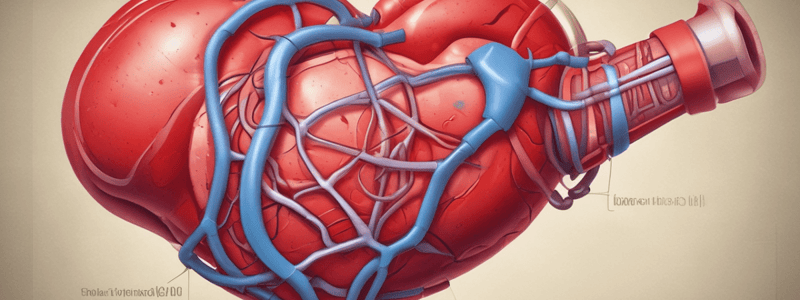Podcast
Questions and Answers
Which cholesterol levels are considered healthy?
Which cholesterol levels are considered healthy?
- HDL > 40 in men and > 50 in women
- LDL < 150
- Both a and b (correct)
- None of the above
Statins have no effect on HDL levels.
Statins have no effect on HDL levels.
False (B)
What is the primary purpose of statins?
What is the primary purpose of statins?
Lower LDL and total cholesterol
Statins are most effective when given in the ______ due to cholesterol synthesis.
Statins are most effective when given in the ______ due to cholesterol synthesis.
What are potential side effects of statins?
What are potential side effects of statins?
Which drug is used as an adjunct to statins?
Which drug is used as an adjunct to statins?
Nicotinic acid is also known as ______.
Nicotinic acid is also known as ______.
What is the main action of Ezetimibe?
What is the main action of Ezetimibe?
Gemfibrozil significantly reduces LDL levels.
Gemfibrozil significantly reduces LDL levels.
What can be the side effects of Bempedoic acid?
What can be the side effects of Bempedoic acid?
What is the recommended first-line treatment for exertional angina?
What is the recommended first-line treatment for exertional angina?
In stable angina, the goal is to ______ cardiac oxygen demand.
In stable angina, the goal is to ______ cardiac oxygen demand.
Match the drug class with its effect on angina:
Match the drug class with its effect on angina:
What is the process for antianginal therapy in variant angina?
What is the process for antianginal therapy in variant angina?
Ranolazine can reduce heart rate and blood pressure.
Ranolazine can reduce heart rate and blood pressure.
Flashcards are hidden until you start studying
Study Notes
CAD Prevention
- HDL levels: >40 for men, >50 for women
- LDL levels: <150
- Drugs for LDL lowering: statins, bile acid sequestrants, monoclonal antibodies, and ezetimibe
- Statins:
- Most effective for lowering LDL and total cholesterol
- Can raise HDL and lower triglycerides
- Promote atherosclerotic plaque stability, reduce inflammation, and improve endothelial function
- Most effective when given in the evening due to cholesterol synthesis at night
- Lifelong treatment; if stopped, cholesterol levels return to baseline
- Recommended for diabetes patients with LDL > 100
- Adverse effects: hepatotoxicity, nephrotoxicity, myopathy, and teratogenicity
- Nicotinic acid or niacin:
- Increases HDL, reduces LDL and triglycerides
- Adverse effect: severe flushing; take ASN prior
- Bile acid sequestrants (colesevelam, cholestyramine, and colestipol):
- Reduce LDL; used as adjuncts to statins
- Adverse effect: GI (constipation)
- Oral meds that interact should be administered 1 hour before or 4 hours after sequestrant
- Ezetimibe:
- Inhibits dietary cholesterol absorption and reabsorption
- Reduces total cholesterol, LDL, triglycerides, and apolipoprotein B; increases HDL
- Adverse effects: myopathy, rhabdomyolysis, hepatitis, pancreatitis, and low platelet count
- Interacts with statins, bile acid sequestrants, fibrates, and cyclosporine
- Bempedoic acid:
- New non-statin medication; approved for patients with familial hypercholesterolemia maxed on statins
- Adverse effects: joint swelling, pain, or rupture
- Bempedoic acid/ezetimibe:
- Should be saved for patients with true statin intolerance
- Gemfibrozil:
- Decreases triglycerides and raises HDL; does not reduce LDL significantly
- Limited to patients who have not responded to weight control and diet modification
- Adverse effects: gallstones, myopathy, and liver injury
- Displaces warfarin, increasing anticoagulant effects; warfarin may need to be reduced
- Increases risk of statin-induced myopathy
- Alirocumab and evolocumab (PCSK9 inhibitors):
- Subcutaneous administration
- Hypersensitivity reactions: vasculitis, rash, urticarial
- Risk of developing antibodies due to protein composition
Drugs for Angina
- Organic nitrates, beta blockers, and calcium channel blockers can be used to increase cardiac oxygen supply or decrease oxygen demand
- Ranolazine can be combined with these drugs to supplement their effects
Stable Angina
- Decrease cardiac oxygen demand
- Avoid factors that precipitate angina and correct risk factors
- Beta blockers:
- First-line treatment for exertional angina
- Not effective against variant angina
- Nitrates:
- Act directly on vascular smooth muscle
- Decrease pain of exertional angina by decreasing cardiac oxygen demand
- In variant angina: acts by relaxing or preventing spasm in coronary arteries, increasing oxygen supply
- Adverse effects: headache, orthostatic hypotension, and reflex tachycardia
- Caution when used with drugs that lower blood pressure, avoid alcohol
- Tolerance to nitrate-induced vasodilation can occur; use lowest dose, long-acting formulation, and intermittent schedule
- Calcium channel blockers:
- Can be used in both stable and variant angina
Variant Angina
- Increase cardiac oxygen supply
- Vasodilators: calcium channel blockers and nitrates
- Process for antianginal therapy:
- Initial: calcium channel blockers or long-acting nitrate
- If either drug alone is inadequate, combine therapy with calcium channel blockers + nitrate
- If combination fails, consider CABG
Ranolazine
- New class of antianginal agents
- Works by reducing accumulation of sodium and calcium in myocardial cells
- Does not reduce heart rate, blood pressure, or vascular resistance
- Can prolong QT interval
- Risk of torsades with CYP inhibitors
- Should utilize antiplatelet aspirin (75-162mg daily) or clopidogrel
Studying That Suits You
Use AI to generate personalized quizzes and flashcards to suit your learning preferences.




